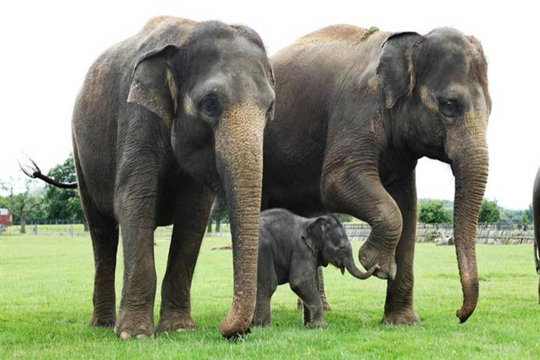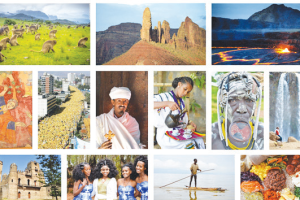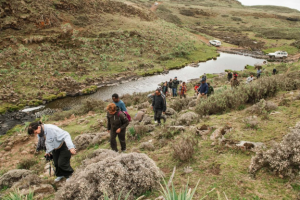
The renovation of the existing and the construction activity of new tourism destinations across the country is continuing in a more concerted manner than before.
Particularly, over the past years, following the initiatives launched by Prime Minister Abiy Ahmed, dubbed as ‘Dine for Sheger’, ‘Dine for Nation’ ‘Dine for Generation’ projects, massive renovation and construction works of tourist destinations are undertaken in all parts of the country.
Among the areas getting due attention in these initiatives, the Chebera-Churchura National Park, which is located in the Dawuro Zone of South West Ethiopia and part of the ‘Dine for Nation’ project is the one.
The area apart from having a breathtaking natural beauty, it harbors diverse birds and 37 species of larger mammals. It provides home to wild African elephants that are commonly rare within the protected forest areas and open grasslands, by which the park harbors over 500 individuals moving in different herds.
Watching wild animals, mainly a parade of elephants walking gracefully within the park, as well as the buffalo, antelope and deer is a common scene.
As to documents, the park contains four types of habitats, grasslands, woodlands, mountain forest and riverine forests. Most of the park which is covered by 62 percent is wooded grassland dominated by elephant grass (Pennisetum purpureum), with montane woodland comprising 29 percent along with woodland and riparian forest the rest.
Palm trees are significantly diverse within the park’s ecoregion. Dominant woody vegetation includes Ficus, Combretum, Ehertia, and Albizia species. The natural forest harbors non-timber forest products known for economic value such as Enset, coffee, coriander, and piper species. So far, 106 woody plant species were identified of which six are endemic to Ethiopia.

The park is home to 37 species of large mammals. It provides home to wild African elephants that are commonly rare within the protected forest areas and open grasslands, by which the park harbors over 500 individuals moving in different herds. Mammals that are also found in Chebera Churchura national park include lions, leopards, servals, greater kudus, colobus monkeys, vervet monkeys, hippos, defassa waterbucks, warthogs, and Cape buffalos.
There are also 237 species of birds in the park. Among these species of birds, white-winged cliff chat, banded barbet, Wattled Ibis, Ethiopian oriole, and thick-billed raven are endemic to Ethiopia.
According to Philip Briggs, a renowned Africa expert and author of many Bradt guidebooks to African destinations, including the guide to Ethiopia, Chebera-Churchura National Park is one of the last elephant strongholds in Ethiopia.
Philip wrote in his webpage that the Chebera-Churchura National Park has a good variety of animals. The game rangers are skilled at tracking elephants and buffalos. Other wildlife one might spot while hiking includes lesser and greater kudu, defassa waterbuck, hippo, bushpig and giant forest hog. Guereza monkeys are common in the riverine forest, while Vervet monkeys offer lots of entertainment in the campsite.
“Nature-lovers wishing to get off-the-beaten-track should consider a visit to Chebera-Churchura National Park. The elephants are shy, but tracking these giants in the jungle is a thrilling experience.
While expressing the area Philip said that, due to the large span of altitudes, Chebera-Churchura covers a lot of different habitats and landscapes. There is a big chunk of lush jungle-like forest crisscrossed by streams and animal paths. Further afield the forest thins and gives way to woodland savannah. Several hot springs and crater lakes can be reached on hiking excursions.
And the best time to visit the Park, according to the expert, is in the dry season from November to February. The park is best explored on foot, so the wet season months from April to October can be a bit more challenging. However, the scenery is at its best during this time.
Last Saturday, this stunning, naturally endowed tourist attraction, ‘Chebera Elephant Paw Lodge’ within the Chebera Churchura National Park was inaugurated by Prime Minister Abiy Ahmed in the presence of, Deputy Prime Minister and Foreign Minister Demeke Mekonnen, Speaker of the House of People’s Representatives, Tagesse Chafo, regional chief administrators and high ranking government officials, as well as invited guests.
The lodge located between Konta and Dawro Zones is part of the Premier’s tourism destination projects being constructed in the country through the ‘Dine for Nation” initiative, it was learnt.
According to documents, the park is highly attractive because of its undulating landscape with high hills, rolling plains with incised rivers and perennial streams, four small crater lakes (Keriballa, Shasho, Koka) valleys, and gorges. The rivers are lined by dense forests, which provide habitat for the Buffaloes and elephants, as well as forest birds like trogon and turacos.
The park covers a total area of 11,900 hectare/1250 square kilometers and elevations range from 500-2000 meters above sea level. Its annual rainfall ranges from 1200 mm to 2300 mm and temperature ranges from 10-29°C. Wet seasons are from March to September and dry seasons are from December to February. The park harbors four small creator lakes such as Keriballa, Koka, and Shasho. There are 49 perennial rivers crossing the park. The river Zinga which is one of the tributaries of the Omo River rises from the northeast highlands of the area and crosses the central part of the park.
The Shoshuma River rises from the northwestern highlands of the Konta area, flows across the northeastern part of the park and joins the Zinga River inside the park and drains to Omo River. There are also natural caves existing in the park.
The park also contains various hot and cold springs like Toshima, Nechwuha (to mean white water) and waterfalls like Barbo waterfall.
COMPILED BY STAFF REPORTER
THE ETHIOPIAN HERALD FRIDAY 29 DECEMBER 2023





